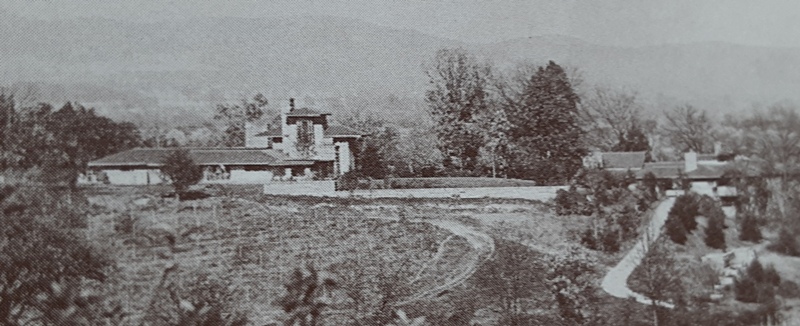Looking north at Taliesin, 1920-24. On the far left is a workman’s apartment. The vertical tower to the right of the apartment is called the “Hill Tower”. On the far right are Wright’s living quarters. The workman’s apartment and Wright’s living quarters are connected under roofs. But, you can’t see it all because the building wraps around the hill.
April 20 is the anniversary of the second fire at Taliesin: April 20, 1925. That fire (like the first one in 1914) pretty much destroyed Frank Lloyd Wright’s living quarters down to the chimneys and foundation. Fortunately no one was hurt.
Part of what Wright said about the fire:
In his autobiography, he wrote:
[O]ne evening at twilight as the lightning of an approaching lightning storm was playing and the wind rising I came down from the evening meal in the little detached dining room on the hill-top . . . to find smoke pouring out of my bedroom. Again–there it was–Fire!
Frank Lloyd Wright, An Autobiography, in Frank Lloyd Wright Collected Writings: 1930-32, volume 2. Edited by Bruce Brooks Pfeiffer, introduction by Kenneth Frampton (1992; Rizzoli International Publications, Inc., New York City, 1992), 294.
The “little detached dining room”? Where was that?
The “little detached dining room” isn’t connected to Taliesin’s living quarters. It’s connected to its Hill Tower. So you can find the room in the photograph at the top of the page by following the line of the tower down. The room is under the low-hipped roof above a horizontal rectangle of stone. Here’s a link to a photograph of the room, available at the Wisconsin Historical Society.
What was the cause of the 1925 fire?
According to Wright: “. . . . The fire had originated in a house-telephone that had given trouble as it stood by the head of my bed.” [An Autobiography in “Collected Writings,” volume 2, 295.]
Wright and the others at Taliesin that day spent several hours fighting the fire. And Wright was so desperate to save the building that, along with burning the soles of his feet, he burned his eyebrows off.
Description of one of those at Taliesin that day:
Draftsman Kameki Tsuchiura, who worked at Taliesin with his wife (draftsperson Nobuko Tsuchiura), wrote this on April 211:
We carried water in buckets but how helpless, we were only, Mr. Wright, I and Nobu, Mrs. Ohlson and Jack and [Mel, the chauffeur]. . . . We connected the hose to the water pipe and firemen came, but too late. His apartment, and all the guest apartment [sic] were burning. Strong wind blew from east to west. Such a smoke and flame that no one could get in the house to bring anything out. We could only cut the roof [that connected] Mr. Wright’s kitchen and studio and prevent the fire from spreading west. After 9 o’clock, wind changed, rain started to drop. And what a night we had till midnight, fire, thunderstorm, lightening and more fire!!
William Blair Scott Jr Collection, OA+D Archives
There is a book in Japanese on the architecture of Nobuko Tsuchiura. While I don’t know the full title (I don’t read Japanese), it translates in part as, “Big Little Nobu”. But the book include a photograph that shows the Taliesin living quarters after that second fire. So I put that below. It was taken at floor level, looking north. The fireplace you see on the right is now the fireplace in what became Olgivanna Lloyd Wright’s bedroom.

In the book, “Big Little Nobu, Right No Deshi Josei Kenchikuka Tsuchiura Nobuko”
ISBN: 9784810705416.
You can find the book on-line. Its ISBN is 9784810705416. ⇐I originally wrote that number incorrectly. Thanks to one of the readers for catching that and contacting me.
While no one got hurt, Wright lost a lot of the art he collected while working in Japan
He wrote:
Left to me out of most of my earnings, since Taliesin I was destroyed, all I could show for my work and wanderings in the Orient for years past, were the leather trousers, burned socks, and shirt in which I stood, defeated, and what the workshop contained.
[An Autobiography in “Collected Writings,” volume 2, 295.]
Personally, it would be difficult not to think that the universe had something out for me. However, then Wright wrote this:
But Taliesin lived wherever I stood! A figure crept forward from out of the shadows to say this to me. And I believed what Olgivanna said.
[An Autobiography in “Collected Writings,” volume 2, 295.]
Olgivanna would become his third wife. I think it’s kind of cool that his description—when Olgivanna said “Taliesin lived wherever” he stood—is the first time that Frank Lloyd Wright mentioned Olgivanna.
Wright starts building “Taliesin III”
During Taliesin’s rebuilding, Wright put pieces of destroyed statuary into the walls:
Smoldering or crumbled in ashes, priceless blossoms-of-the-soul in all ages—we call them works of Art—lay broken, or had vanished utterly. . . .
A few days later clearing away the debris to reconstruct I picked up partly calcined marble heads of the Tang-dynasty, fragments of the black basalt of the splendid Wei-stone, Sung soft-clay sculpture and gorgeous Ming pottery turned to the color of bronze by the intensity of the blaze. The sacrificial offerings to—whatever Gods may be.
And I put these fragments aside to weave them into the masonry—the fabric of Taliesin III that now—already in mind—was to stand in place of Taliesin II. And I went to work.
[An Autobiography in “Collected Writings,” volume 2, 295.]
First published April 16, 2021
The photograph at the top of this post appears with the essay, “The Story of Taliesin: Wright’s First Natural House,” by Neil Levine, in Taliesin 1911-1914, Wright Studies, v. 1, ed. Narciso Menocal (Southern Illinois University Press, Carbondale and Edwardsville, Illinois, 1992), fig. 1, p. 3.
1 I mentioned this couple in my post, Taliesin II: The Forgotten Middle Child of Taliesin.

